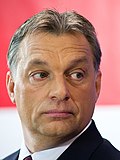Hungarian parliamentary election, 2014
|
|
|||||||||||||||||||||||||||||||||||||||||||||||||||||||||||||||||
|---|---|---|---|---|---|---|---|---|---|---|---|---|---|---|---|---|---|---|---|---|---|---|---|---|---|---|---|---|---|---|---|---|---|---|---|---|---|---|---|---|---|---|---|---|---|---|---|---|---|---|---|---|---|---|---|---|---|---|---|---|---|---|---|---|---|
|
|||||||||||||||||||||||||||||||||||||||||||||||||||||||||||||||||
|
|
|||||||||||||||||||||||||||||||||||||||||||||||||||||||||||||||||
|
All 199 seats in the Országgyűlés 100 seats needed for a majority |
|||||||||||||||||||||||||||||||||||||||||||||||||||||||||||||||||
| Turnout | 61.73% | ||||||||||||||||||||||||||||||||||||||||||||||||||||||||||||||||
|
|||||||||||||||||||||||||||||||||||||||||||||||||||||||||||||||||

|
|||||||||||||||||||||||||||||||||||||||||||||||||||||||||||||||||
|
|||||||||||||||||||||||||||||||||||||||||||||||||||||||||||||||||
The 2014 Hungarian parliamentary election took place on 6 April 2014. This parliamentary election was the 7th since the 1990 first multi-party election. The result was a victory for the Fidesz–KDNP alliance, preserving its two-thirds majority, with Viktor Orbán remaining Prime Minister. It was the first election under the new Constitution of Hungary which came into force on 1 January 2012. The new electoral law also entered into force that day. For the first time since Hungary's transition to democracy, the election had a single round. The voters elected 199 MPs instead of the previous 386 lawmakers.
After the 2010 parliamentary election, Fidesz won a landslide victory, with Viktor Orbán being elected as Prime Minister. As a result of this election, his government was able to alter the National Constitution, as he garnered a two thirds majority. The government was able to write a constitutional article that favored traditional marriages, as well as one that lowered the number of MPs elected from 386 to 199.
Orbán and his government remained relatively popular in the months leading to the election. This was largely because of high GDP growth, increased industrial output, and a growth in the tourism sector.
The National Election Office announced that a total of 2,304 candidates submitted the required number of nominations for the parliamentary election by the 3 p.m. deadline on 4 March. The candidacy of 1,531 people was accepted after completion of the registration process. The following table contains a selected list of numbers of individual candidates by county representation and party affiliation:
Under the new election law, parties which ran individual candidates in at least 27 constituencies in Budapest and at least nine counties had the opportunity to set up a national list. On 21 February 2014, the National Election Committee (NVB) registered at first the joint list of the governing Fidesz–KDNP party alliance, led by PM Viktor Orbán and KDNP president Zsolt Semjén.
...
Wikipedia




